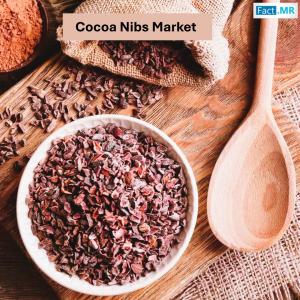Cocoa Nibs Market to Surpass US$ 1.2 Billion, Expanding at 6.8% CAGR by 2035: Fact.MR Analysis
Cocoa Nibs Market Poised for Robust Growth with Increasing Demand for Health-Conscious Snacking
ROCKVILLE, MD, UNITED STATES, May 28, 2025 /EINPresswire.com/ -- The global cocoa nib market is expected to reach USD 610.4 million in 2025 at a growth rate of CAGR 6.8%, will touch USD 1.2 billion by 2035. The market growth is spurred by the high demand for minimally processed, high-antioxidant-containing ingredients in health-conscious food items, baking, and snack foods. Cocoa nibs, which consist of fermented, dried, and roasted cocoa beans, are gaining popularity due to their natural ingredient composition, deep chocolate flavor, and nutrient concentration.Increasing customer demand for plant-based superfoods with high fiber, high magnesium, and flavonoid composition is also fueling the demand. These ground cocoa beans are going everywhere in clean-label and functional foods, particularly across North America and Europe. Health-focused middle-class consumers in emerging markets like Asia-Pacific are increasingly consuming cocoa nibs as a premium snacking ingredient in conventional retailing and online channels. Plant-based eating and expanding low-sugar snacking trends are also contributing to the size of this market.
The trend toward bean-to-bar craft chocolate manufacturing in Europe and the United States is creating commercial opportunities for cocoa nibs in the specialty chocolate and artisanal bakery markets. Companies that focus on traceability, ethical sourcing, and regional flavor profiles are drawing increased attention from premium product developers.
For More Insights into the Market, Request a Sample of this Report:
https://www.factmr.com/connectus/sample?flag=S&rep_id=10777
Key Drivers Behind the Growth of the Cocoa Nibs Market
The cocoa nibs market is increasing rapidly due to a combination of factors. Firstly, increased consumer demand for low-processed, natural foods is driving the popularity of cocoa nibs as healthy, nutrient-dense ingredients. High antioxidant, magnesium, and fiber content is putting cocoa nibs in great demand as a sought-after ingredient in healthy foods like granola bars, trail mix, and smoothie bowls.
Moreover, expansion in the low-sugar and plant-based snack markets is propelling demand. Cocoa nibs are gaining popularity as healthier options among consumers, supporting the expansion of clean-label products and functional foods. Moreover, innovation in the bean-to-bar trend in the production of chocolate is also supporting the demand for cocoa nibs in both commercial and artisanal applications.
Regional Insights
North America is the leading market for cocoa nibs, driven by the health-conscious food and functional foods trend. Europe is second, with consumers increasingly turning to premium as well as sustainably sourced ingredients for application in health-oriented food products. The Asia-Pacific region is also witnessing strong market growth in countries such as China, India and Southeast Asia, which is fueled by middle-class consumption growth and superfood awareness. These markets are capitalizing on retail transformation, especially in the online space, to increase access to cocoa nibs for consumers.
Middle East & Africa and Latin America are growth markets where demand for cocoa nibs is building steam based on consumer interest in clean-label and natural foods.
Key Takeaways from the Market Study
The cocoa nibs market is projected to grow from USD 610.4 million in 2025 to USD 1.2 billion by 2035, expanding at a CAGR of 6.8%.
Organic cocoa nibs are expected to capture 35% of the market in 2025, driven by increasing consumer demand for clean-label, sustainably sourced products.
Asia-Pacific is emerging as a high-growth region, with countries like China, India, and Southeast Asia showing increasing consumption of cocoa nibs.
Food & beverage applications will dominate the market with a 50% share in 2025.
Survey Insights and Stakeholder Priorities
A Fact.MR survey identifies some key trends in the cocoa nibs market. 82% of the stakeholders recognize the need for antioxidant integrity and label transparency to address the consumer demands for clean, minimally processed products. 69% of the stakeholders identified the cocoa nibs' flexibility across multiple uses, from bakery to beverages to snacks.
Regional dynamics also influence stakeholder choices. The North American players emphasize organic sourcing and functional snacking, whereas European players are interested in premium positioning for gourmet use. In Asia-Pacific, changing retail dynamics and rising adoption of superfoods are influencing market growth.
Technological innovation also plays a prime role in the cocoa nibs industry. Micro-roasting, moisture-controlled warehousing, and high-precision sorting are gaining popularity among top manufacturers. Roasting in small batches is popular in North America due to flavor consistency, while purity and single-origin standardization are the emphasis in Europe. Smart packaging to ensure extended shelf life and to fit local climatic conditions is being invested in by Asia-Pacific.
Get Customization on this Report for Specific Research Solutions:
https://www.factmr.com/connectus/sample?flag=S&rep_id=10774
Market Leaders Defining the Cocoa Nibs Industry
Key players in the industry of cocoa nibs include Barry Callebaut AG, Cargill, Incorporated, Olam Food Ingredients (ofi), Cemoi Group, ECOM Agroindustrial Corp. Limited, Sunfood.
Check out More Related Studies Published by Fact.MR:
The global plant-based cheese market, currently valued at USD 1.3 billion, is expected to grow at a CAGR of 15.1%, reaching USD 5.3 billion by 2033.
According to Fact.MR, the nutritional yeast market is valued at USD 620.7 million in 2025 and is projected to grow at a CAGR of 7.1%, reaching USD 1,229.8 million by 2035.
About Us:
Fact.MR is a distinguished market research company renowned for its comprehensive market reports and invaluable business insights. As a prominent player in business intelligence, we deliver deep analysis, uncovering market trends, growth paths, and competitive landscapes. Renowned for its commitment to accuracy and reliability, we empower businesses with crucial data and strategic recommendations, facilitating informed decision-making and enhancing market positioning.
With its unwavering dedication to providing reliable market intelligence, FACT.MR continues to assist companies in navigating dynamic market challenges with confidence and achieving long-term success. With a global presence and a team of experienced analysts, FACT.MR ensures its clients receive actionable insights to capitalize on emerging opportunities and stay competitive.
Contact:
11140 Rockville Pike
Suite 400
Rockville, MD 20852
United States
Tel: +1 (628) 251-1583
Sales Team: sales@factmr.com
Follow Us: LinkedIn | Twitter | Blog
S. N. Jha
Fact.MR
+1 628-251-1583
sales@factmr.com
Legal Disclaimer:
EIN Presswire provides this news content "as is" without warranty of any kind. We do not accept any responsibility or liability for the accuracy, content, images, videos, licenses, completeness, legality, or reliability of the information contained in this article. If you have any complaints or copyright issues related to this article, kindly contact the author above.
Cellular Health Supplement Market Reach USD 3,668.1 Million by 2035 as Demand for Anti-Aging & Immunity Support Surges
Autonomous Robots Market to Reach USD 34.64 Billion by 2035, Powered by Healthcare and Logistics Demand
Synthetic Zeolites Market | Industry Insights 2031: Demand Trends & Global Expansion
Więcej ważnych informacji
 Jedynka Newserii
Jedynka Newserii

 Jedynka Newserii
Jedynka Newserii

Farmacja

Nowy pakiet farmaceutyczny ma wyrównać szanse pacjentów w całej Unii. W Polsce na niektóre leki czeka się ponad dwa lata dłużej niż w Niemczech
Jeszcze pod przewodnictwem Polski Rada UE uzgodniła stanowisko w sprawie pakietu farmaceutycznego – największej reformy prawa lekowego od 20 lat. Ma on skrócić różnice w dostępie do terapii między krajami członkowskimi, które dziś sięgają nawet dwóch–trzech lat. W Unii Europejskiej wciąż brakuje terapii na ponad 6 tys. chorób rzadkich, a niedobory obejmują również leki ratujące życie. Nowe przepisy mają zapewnić szybszy dostęp do leków, wzmocnić konkurencyjność branży oraz zabezpieczyć dostawy.
Handel
Wzrost wydobycia ropy naftowej nie wpłynie na spadek cen surowca. Kierowcy jesienią zapłacą więcej za olej napędowy

Sierpień jest trzecim z rzędu miesiącem, gdy osiem krajów OPEC+ zwiększa podaż ropy naftowej na globalnym rynku; we wrześniu nastąpi kolejna zwyżka. Kraje OPEC, zwłaszcza Arabia Saudyjska, chcą w ten sposób odzyskać udziały w rynku utracone na skutek zmniejszenia wydobycia od 2022 roku, głównie na rzecz amerykańskich producentów. Nie należy się jednak spodziewać spadku cen ropy, gdyż popyt powinien być wysoki, a pod znakiem zapytania stoi dostępność ropy z Rosji. Nie zmienia to faktu, że jesienią ceny paliw na stacjach zazwyczaj rosną, a w największym stopniu podwyżki dotyczyć będą diesla.
Nauka
Szacowanie rzeczywistej liczby użytkowników miast dużym wyzwaniem. Statystycy wykorzystują dane z nowoczesnych źródeł

Różnica między liczbą rezydentów a rzeczywistą liczbą osób codziennie przebywających w Warszawie może sięgać nawet niemal pół miliona. Rozbieżności są dostrzegalne przede wszystkim w dużych miastach i ich obszarach funkcjonalnych. Precyzyjne dane populacyjne są tymczasem niezbędne w kształtowaniu usług społecznych i zdrowotnych, edukacyjnych, opiekuńczych, a także w planowaniu inwestycji infrastrukturalnych. W statystyce coraz częściej dane z oficjalnych źródeł, takich jak Zakład Ubezpieczeń Społecznych, są uzupełniane o te pochodzące od operatorów sieci komórkowych czy kart płatniczych.
Partner serwisu
Szkolenia

Akademia Newserii
Akademia Newserii to projekt, w ramach którego najlepsi polscy dziennikarze biznesowi, giełdowi oraz lifestylowi, a także szkoleniowcy z wieloletnim doświadczeniem dzielą się swoją wiedzą nt. pracy z mediami.









.gif)

 |
| |
| |
|